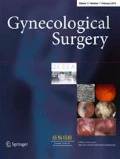Abstract
The aim of this study was to analyze the characteristics and peculiarity of non-tubal ectopic (NTE) pregnancy presenting to a major district hospital in London, UK. Data were collected between January 2003 and July 2014. There were 850 cases of ectopic pregnancies (798 tubal pregnancies and 53 NTE pregnancies). Forty-seven of the NTE were included in the study. Data were analyzed using IBM SPSS Statistics 20. Pearson’s chi-squared analysis was used to compare statistical significance of the data collected; the level of statistical significance at which the null hypothesis was rejected was chosen as 0.05. The 31–40 year age group had the highest incidence (55 % of the cohort). Thirty-seven percent of NTE were primigravida. Most of the women presented at 6–10 weeks gestation (63 %) with abdominal and vaginal bleeding being the most common presentation in 55 % of cases. When compared with tubal ectopic pregnancy, NTE was more likely to present at later gestation of presentation (p = 0.000), have history of assisted reproduction (p = 0.041) and more likely to present with diarrhoea, shoulder-tip pain and syncopal attack as well having a significant amount of haemoperitoneum at surgery compared with tubal ectopic pregnancy. NTE pregnancies are likely to present most commonly at 6–10 weeks and therefore clinicians should have a high index of suspicion when treating any pregnant woman at this gestation. The later presentation of NTE pregnancies may relate to the delay in diagnosis of these rarer ectopic pregnancies; this may be attributed to the clinician having a level of suspicion that is too low, as the incidence of NTE pregnancies is becoming increasingly common. A combination of a thorough history with the presence of specific risk factors such as a history of assisted conception, pelvic surgery and pelvic inflammatory disease and symptoms such as syncope and an abnormal amount of free fluid behind the empty uterus at ultrasound should make the clinician highly suspicious of a NTE or heterotopic pregnancy.

Similar content being viewed by others
References
Knez J (2014) Ultrasound imaging in the management of bleeding and pain in early pregnancy Best Practice and Research. Clin Obstet Gynaecol 28(5):621–636
Alkatout I, Honemeyer U, Strauss A, Tinelli A, Malvasi A, Jonat W, Mettler L, Schollmeyer T (2013) Clinical diagnosis and treatment of ectopic pregnancy. Obstet Gynecol Surv 68(8):571–581
Verma U, English D, Brookfield K (2011) Conservative management of non-tubal ectopic pregnancies. Fertil Steril 96(6):1391–1395
Office of National statistics (2011) Live Births in England and Wales by characteristics of mother 1, 2010
Shan N, Dong D, Deng W, Fu Y (2014) Unusual ectopic pregnancies: a retrospective analysis of 65 cases. J Obstet Gynaecol Res 40:147–154
Yao B, Chen R (1997) Clinical analysis of unusual ectopic pregnancies. A report of 27 cases. Chin J Pract Gynecol Obstet 13:33–35
Chetty M, Elson J (2009) Treating non-tubal ectopic pregnancy. Best Pract Res Clin Obstet Gynaecol 23:529–538
Centre for disease control and prevention (Nov 2009) 2008 sexually transmitted disease surveillance
Lozeau AM, Potter B (2005) Diagnosis and management of ectopic pregnancy. Am Fam Phys 72(9):1707–1714
Rimdusit P, Kasatri N (1976) Primary ovarian pregnancy and intrauterine contraceptive device. Obstet Gynaecol 48:57–59
Kakade A (2012) Ovarian ectopic pregnancy: varied clinical presentations- 3 case reports and review of literature. Indian J Basic Appl Med Res 3(1):242–244
Lehefeldt H, Tietze C, Gorstein F (1970) Ovarian pregnancy and the intrauterine device. Am J Obstet Gynaecol 108:1005–1009
Kirk EAB, Bottomley C, Bourne T (2014) Diagnosing ectopic pregnancy and current concepts in the management of the pregnancy of unknown location. Hum Reprod 20(2):250–261
Odejinmi F, Rizzuto MI, Macrae R, Olowu O, Hussain M (2009) Diagnosis and laparoscopic management of 12 consecutive cases of ovarian pregnancy and review of literature. J Minim Invasive Gynecol 16(3):354–359
Habbu J, Read MD (2006) Ovarian pregnancy successfully treated with methotrexate. J Obstet Gynaecol 26(6):587–588
Compliance with ethical standards
This article does not contain any studies with the human participants or animals performed by any of the authors.
Conflict of interest
We declare that none of the authors have a conflict of interest.
Authors’ contribution
Alalade contributed in project development, data collection, data analysis, manuscript writing and editing.
Mayers contributed in data analysis and manuscript writing.
Abdulrahman contributed in data analysis and manuscript writing.
Oliver contributed in data collection and data analysis.
Odejinmi contributed in project development, data collection, manuscript writing and editing.
Author information
Authors and Affiliations
Corresponding author
Rights and permissions
About this article
Cite this article
Alalade, A., Mayers, K., Abdulrahman, G. et al. A twelve year analysis of non-tubal ectopic pregnancies: Do the clinical manifestations and risk factor for these rare pregnancies differ from those of tubal pregnancies?. Gynecol Surg 13, 103–109 (2016). https://doi.org/10.1007/s10397-015-0917-1
Received:
Accepted:
Published:
Issue Date:
DOI: https://doi.org/10.1007/s10397-015-0917-1




